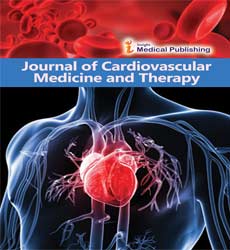Management of Atrial Fibrillation: From Anticoagulation to Catheter Ablation
Jessica Peter*
Department of General Internal Medicine 3, Kawasaki Medical School General Medicine Centre, Okayama 700-8505, Japan
*Corresponding author:
Jessica Peter,
Department of General Internal Medicine 3, Kawasaki Medical School General Medicine Centre, Okayama 700-8505, Japan,
E-mail: Peter.jessica@yahoo.co.jp
Received date: February 01, 2025, Manuscript No. ipcmt-25-20686; Editor assigned date: February 03, 2025, PreQC No. ipcmt-25-20686 (PQ); Reviewed date: February 15, 2025, QC No. ipcmt-25-20686; Revised date: February 22, 2025, Manuscript No. ipcmt-25-20686 (R); Published date: February 28, 2025
Citation: Peter J (2025) Management of Atrial Fibrillation: From Anticoagulation to Catheter Ablation. J Cardiovasc Med Ther Vol.8 No.1:05
Introduction
Atrial Fibrillation (AF) is the most common sustained cardiac arrhythmia globally, affecting millions of individuals and contributing significantly to morbidity, mortality and healthcare burden. Characterized by disorganized atrial electrical activity, AF leads to ineffective atrial contraction, irregular ventricular response and increased risk of thromboembolic events, particularly ischemic stroke. The prevalence of AF rises with age and is associated with comorbid conditions such as hypertension, diabetes mellitus, heart failure, coronary artery disease and obesity. Its clinical presentation varies from asymptomatic episodes detected incidentally to palpitations, dyspnea, fatigue and heart failure exacerbations, complicating diagnosis and management [1].
The management of AF requires a comprehensive, multidisciplinary approach that addresses rhythm control, rate control, stroke prevention and the treatment of underlying comorbidities. Historically, therapeutic strategies focused on controlling heart rate and preventing thromboembolic events through anticoagulation. However, advances in pharmacology, device therapy and interventional cardiology have expanded the therapeutic armamentarium to include novel oral anticoagulants (NOACs), antiarrhythmic medications and catheter-based ablation techniques. Integrating these strategies with lifestyle modification and management of cardiovascular risk factors has transformed AF care from reactive treatment of symptoms to proactive prevention of complications.
Description
Stroke prevention is a cornerstone of AF management due to the fivefold increased risk of ischemic stroke in affected individuals. Oral anticoagulation significantly reduces thromboembolic events by inhibiting clot formation within the fibrillating atria, particularly the left atrial appendage, which is the primary site of thrombus development. Vitamin K antagonists, such as warfarin, have long been used for stroke prevention but require frequent monitoring, dose adjustments and dietary restrictions. The advent of Direct Oral Anticoagulants (DOACs), including dabigatran, rivaroxaban, apixaban and edoxaban, has simplified anticoagulation by offering predictable pharmacokinetics, fixed dosing, fewer drug interactions and no need for routine laboratory monitoring. Clinical trials demonstrate that DOACs are at least as effective as warfarin in preventing stroke, with lower rates of major bleeding, particularly intracranial hemorrhage. Risk stratification tools, patient education and shared decision-making are essential to optimize anticoagulation therapy, balancing the risk of stroke against bleeding complications [2].
Rate control is another fundamental aspect of AF management, particularly in patients with persistent or permanent AF or those who are minimally symptomatic. Achieving appropriate ventricular rate prevents tachycardia-induced cardiomyopathy, alleviates symptoms and improves exercise tolerance. Beta-blockers, calcium channel blockers and digoxin are commonly used to control heart rate, with selection tailored to patient comorbidities such as heart failure, asthma, or hypotension. The target resting heart rate is generally 60â??100 beats per minute, although lenient rate control may be acceptable in asymptomatic patients. Close monitoring and titration are essential to maintain hemodynamic stability and symptom control [1].
Rhythm control strategies aim to restore and maintain sinus rhythm, improving symptoms and potentially reducing long-term cardiovascular complications. Antiarrhythmic drugs, including class I and III agents such as flecainide, propafenone, sotalol and amiodarone, are commonly used for pharmacologic cardioversion and maintenance of sinus rhythm. Selection is influenced by underlying cardiac function, comorbidities and potential drug toxicity. While antiarrhythmic therapy can be effective, it is limited by proarrhythmic risks and side effects, necessitating careful patient selection and regular monitoring [2].
Catheter ablation has emerged as a transformative intervention for AF, particularly in patients with symptomatic paroxysmal or persistent AF refractory to pharmacologic therapy. The procedure involves percutaneous insertion of catheters into the left atrium, where targeted radiofrequency or cryothermal energy is applied to electrically isolate the pulmonary veins, the most common triggers of AF. Ablation restores sinus rhythm, reduces symptom burden and may improve quality of life and exercise capacity. Recent studies suggest that early ablation, particularly in patients with heart failure or high symptom burden, can improve left ventricular function and reduce hospitalizations. While ablation is generally safe and effective, potential complications include cardiac tamponade, pulmonary vein stenosis and procedure-related thromboembolism, underscoring the need for careful patient selection and peri-procedural anticoagulation.
Conclusion
Atrial fibrillation is a prevalent and clinically significant arrhythmia associated with increased morbidity and mortality, predominantly due to thromboembolic events and heart failure. Effective management requires a multifaceted approach that encompasses stroke prevention, rate and rhythm control, lifestyle modification and treatment of underlying comorbidities. Anticoagulation remains the cornerstone of stroke prevention, with direct oral anticoagulants providing effective and safer alternatives to traditional vitamin K antagonists. Rate and rhythm control strategies, including antiarrhythmic drugs and catheter ablation, address symptomatic burden and may improve cardiac function and quality of life. Catheter ablation, in particular, has emerged as a highly effective intervention for selected patients, offering durable sinus rhythm restoration and improved clinical outcomes.
Lifestyle interventions and management of comorbidities are essential adjuncts that reduce AF recurrence, enhance ablation efficacy and improve overall cardiovascular health. Emerging technologies, including left atrial appendage occlusion devices, advanced mapping systems and AI-driven monitoring, offer new opportunities for personalized and proactive AF care.
Acknowledgement
None.
Conflict of Interest
None.
References
- Sisti N, Valente S, Mandoli G E, Santoro C, Sciaccaluga C, et al.(2020) COVID-19 in patients with heart failure: The new and the old epidemic. Postgrad Med J 97.
Open Access Journals
- Aquaculture & Veterinary Science
- Chemistry & Chemical Sciences
- Clinical Sciences
- Engineering
- General Science
- Genetics & Molecular Biology
- Health Care & Nursing
- Immunology & Microbiology
- Materials Science
- Mathematics & Physics
- Medical Sciences
- Neurology & Psychiatry
- Oncology & Cancer Science
- Pharmaceutical Sciences
